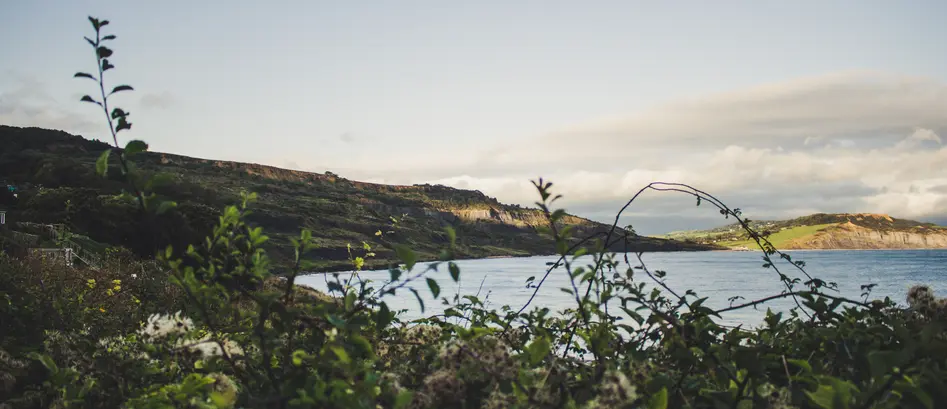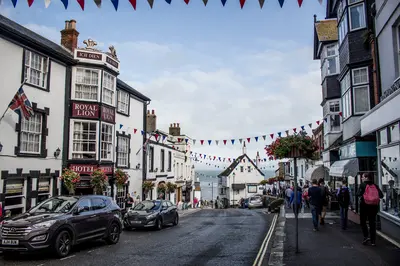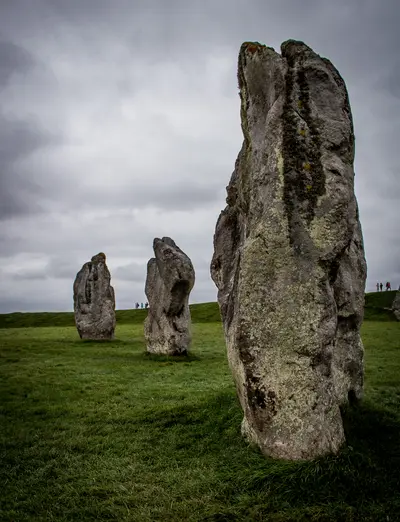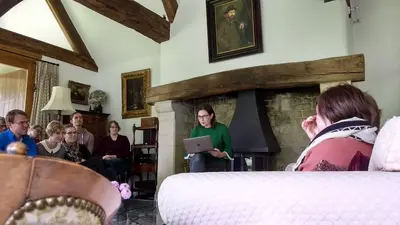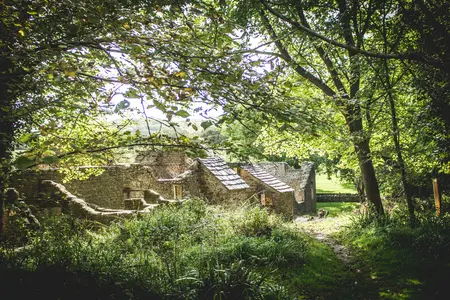Day 1 - Travel day
On 4 September, 2017, at 1:50 in the morning, a group of 34 students and teachers from Bamberg set out for their long coach tour to Dorset in the south of England. While most of us slept (or at least dozed) for the main part of the drive through the continent, everyone was wide awake at Calais, where we took the ferry to Dover. 75 minutes later, the White Cliffs of Dover appeared in the mist and we had arrived in England. After another five-and-a-half-hour drive through the south of England, we finally arrived at Lyme Regis after more than 18 hours of travelling.
In Lyme Regis, English seaside resort and important location in Jane Austen's Persuasion and John Fowles' The French Lieutenant's Woman, we were staying at seven different places because Lyme Regis' picturesque town centre does not provide a hotel or B&B big enough for all of us.
After our very, very long trip of approx. 1,200 km, we finally called it a day.
Day 2 - Lyme Regis
After a well-earned long night's sleep, Lyme Regis welcomed us in daylight with very mixed weather. We started in the morning with a walking tour of Jane Austen's Lyme and a slight drizzle, which later on turned into a torrent of rain, then wind, then drizzle again and then - finally - sunshine. After a short lunch break at the seaside, we set off again for a long walking tour through the Undercliff, the nature reserve next to Lyme. Our guide, Natalie, took us deep into the underbrush, following Fowles' protagonists into the wilderness, and read passages from The French Lieutenant's Woman to us on the way. After our three-hour hike through the thickest and wettest undergrowth, we ended our tour in the Lyme Regis Museum, the museum of Lyme's (paleontological) history. The museum, locally called Philpot Museum after fossil collector and paleontologist Elizabeth Philpot, friend to the famous fossil collector Mary Anning, displays some of the important fossil finds from the area as well as Lyme's historical development since the Middle Ages.
The day was concluded with a few hours of free time to roam the town and, at long last, the sun had come up to stay for the rest of the day.
Day 3 - Bath
On day 3, we left Dorset again for one day and went to Somerset by coach to spend a whole day in the beautiful city of Bath. We started our programme with a tour of Bath led by students Verena Fischer, Marcellina Scheller and Julia Suckfüll, who took us through Bath and explained much of its Georgian architecture until we arrived at the Roman Baths in the very centre of the city. There their tour ended, and we explored the Roman Baths individually. From then onwards, the group was free to roam the city on their own. Some of us took the chance to visit the Jane Austen Centre dedicated to Bath's most famous inhabitant, or Bath's wonderful Fashion Museum; others had cream tea or dinner at the Pump Room or Sally Lunn's, one of Bath's oldest and most famous eating places. Again others took the chance to do some souvenir shopping (Bath has a variety of wonderful little shops, including a Whiskey Store...). After half a free day of exploring, eating and shopping, we met in front of the Abbey and took a little night stroll through Bath to our bus. On the bus, we all fell asleep immediately, while our bus driver, Dirk, took us back to Lyme Regis.
Day 4 - Chesil Beach, Thomas Hardy's Cottage, Stourhead and Avebury
After our relatively free day in Bath, day 4 was to be the longest day on our journey and the one with the most travel destinations. We set out early in the morning to see Chesil Beach, a pebble beach famous for the natural sorting of its pebbles according to size from east (orange size) to west (pea size). On the bus, we listened to a presentation both on the natural formation of the beach and Ian McEwan's book On Chesil Beach. When we arrived, we all took off towards the seafront, although walking on (or rather in) the pebbles proved to be rather exhausting. Since our programme was quite intense, we left again after less than an hour to visit Thomas Hardy's Cottage in Higher Bockhampton. There, we split up in two groups, one group visiting the cottage itself and the other taking a walk through Thorncombe Woods, crossing the Roman Road. After both groups had done the whole programme, we again left in a hurry to get to Stourhead, one of the most famous English estates shown in period dramas. In Stourhead, we started with tea time and a short break and then went off to explore the grounds individually. After that, we again set off by bus to get to Avebury, another henge, but much larger in circumference than Stonehenge, which even has a pub in the middle of the stone circle. We arrived there exactly at sundown, even though the sky was overcast, but the twilight gave the stones and the whole circle a slightly eerie atmosphere. On the drive back to Lyme Regis, we partied hard on the bus to keep everyone going and finally arrived after a long drive throught the nightly English countryside.
Day 5 - Corfe Castle and visit at Natasha Solomons'
Due to our late arrival back to Lyme on day 4, day 5 started a bit later and we took off at 10:30 to see Corfe Castle, a castle demolished by Parliamentarian forces in the English Civil War in 1645, which is now held by the National Trust. Located on a hill, Corfe Castle has a spectacular view over Purbeck in south-east Dorset and even though we had a bit of a drizzle, the weather was good enough to explore the ruins. After Corfe Castle, the day held one of the highlights of our trip: we visited the writer Natasha Solomons, well-known for her novels Mr Rosenblum's List and The Novel in the Viola, in her parents' home. There, we were welcomed by the whole family and invited into their living room where Natasha read from her latest, still unpublished novel and answered our questions about her novels, writing in general, and everything else we wanted to know. After the reading, we were treated to tea and biscuits and could stroll through her mother's beautiful garden. Four years ago, Natasha Solomons taught a creative writing class at the University of Bamberg, and although only few of the students remembered her from 2013, all of us were deeply impressed by her hospitality and we had a very pleasant stay in her parents' house. Visiting an author (and a living author at that!) at home is certainly something you don't do every day! After having said goodbye, we returned to Lyme Regis a little earlier than the days before and some of us took the chance to go swimming in the ocean while others captured the beautiful evening lights on camera. Luckily, nobody drowned, although some nearly did, and the day ended in the pub, the Volunteer.
Day 6 - Tyneham and Durdle Door
The last day of our stay in Dorset again saw mixed weather. We set out to visit Tyneham in bright sunshine on Saturday morning. Tyneham is a modern ghost town. It was requisitioned by the British Army in 1943 to prepare for the D-Day operation with the intent to give it back to its inhabitants after the immediate threat was over. Unfortunately, the town was never given back to its inhabitants and after a long struggle, the premisis were at least opened to the public during the weekends. Since the whole area around Tyneham is a restricted military area, there is only one very narrow road into the village and we had to rent a minibus to take us there in two groups. On the way back from Tyneham, we stopped at Durdle Door, a limestone arch at the coast. Again, the English weather had a few surprises in store for us: While most of us saw Durdle Door and the coast in bright sunshine, six of us got drenched to the bone and a few others got rather wet, too. The spectacular view, however, was worth it, and we had yet another story to tell. After getting our coach back in Dorchester, we went back to Lyme Regis, dried up and met again in the Volunteer for a last dinner (and several drinks) together.
Day 7 - Travel day
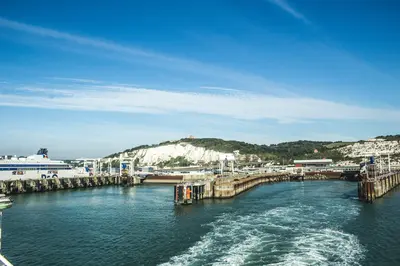
After six adventurous days, we finally had to go back to Germany. On Sunday, we set out at 3:30 in the morning to travel the 1,200 km back to Bamberg. The White Cliffs bade us goodbye in perfect weather and we had our last English breakfast on the ferry before we arrived safely at Calais.
Literary Dorset, a project that had kept us going for nearly a year, had finally come to a close. After a week of literary, geological and historical sights visited in bright sunshine, wind, drizzle or pouring rain, our merry 34 had returned - tired, but even merrier than before.
Thank you very much to Chiara Manghi for organising this wonderful and memorable trip, to Professor Fischer and Professor Houswitschka for their company and supervision and to all participants for being such a great group to travel with. Hope to see you again on our next excursion. Anytime.
